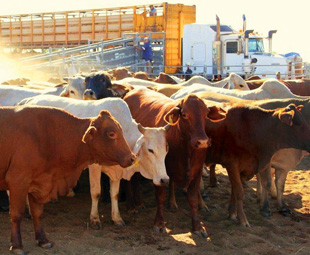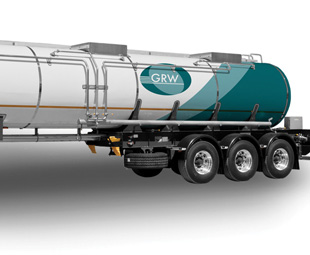Mooovin’ on the highway

FOCUS takes a look at what is required from a trailer to handle the transportation of livestock and food-grade liquids on our roads.
Someday, in our far-flung future, livestock will be transported from planet to planet with the use of Firefly-class freighter spaceships. Until then, animals and produce need to be transported and hither and thither with gravity-obeying, but still high-tech, trailers.
As opposed to the inanimate, cleaned and vacuum-sealed meat products one would buy at the local supermarket, farm animals are most definitely not dead weight to be easily managed, packaged and parcelled.
Considering that evolution has not equipped any four-legged (or bird-brained) herbivorous species with the psychological capacity to adapt to travelling on a highway, special considerations need to be taken into account by trailer manufacturers when creating animal-friendly trailers.
The special needs of each different type of livestock have to be considered by the herders, as each animal type reacts to the highly stressful event of transportation in its own way. In other words, a panicking heard of cows can kick or trample a herder to death. Goats, pigs and sheep can do very much the same, and a brood of chickens – well, who knows what they are capable of …
 Apart from 24 hours of rest for every 28 hours of trailer travel, cattle, for example, are usually quarantined and given veterinary injections to ensure their health and safety. Should a cow fall over during transit, there is always the risk of it being trampled to death by its herd, which in turn means a major monetary loss.
Apart from 24 hours of rest for every 28 hours of trailer travel, cattle, for example, are usually quarantined and given veterinary injections to ensure their health and safety. Should a cow fall over during transit, there is always the risk of it being trampled to death by its herd, which in turn means a major monetary loss.
Furthermore, the adrenaline and other chemicals released by cattle due to stress cause what is known as “dark cutting” meat, meaning the meat becomes visibly darker and tougher than normal. Pinker meat is perceived as more “juicy” and therefore dark cutting can seriously affect the sale price.
However, hygiene and safety does not stop at the animals. For example, considering the fact that the average cow will produce up to 45 kg of dung per day, per cow, and that there are usually quite a few cows on a trailer, one can see why there is a lot of cleaning up to do after a long drive.
As such, trailers are designed to be as user and animal-friendly as possible, including the cleaning process and hygienic maintenance on the trailer itself. One tool that eases this process is known as Cleaning in Place (CIP) lines. By adding a complex matrix of tubes, sprayers, drainage areas and pumps to the inside of a trailer or tanker, much of the cleaning can be done automatically without having to open or enter an area. For livestock, however, this system is sometimes impractical and thus manual labour is still required.
Over the last few years, Dutch company H van Dommelen has developed its own unique and state-of-the-art trailers for transporting livestock across Europe.
Known as the Cattle Cruiser, this innovative trailer has been designed to specifically cater for both the herder and the livestock. Along with on-line fleet maintenance, the Cattle Cruiser’s constant operator feedback allows for real time temperature regulation within the trailer to ensure as comfortable an environment as possible.
The Cattle Cruiser has been designed to milk cows in transit, thus optimising the dairy output and reducing discomfort from swollen udders. Designed with three hydraulically adjustable decks, the trailer can quickly be modified to accommodate other types of livestock such as chickens and sheep.
When transporting fresh produce and liquids, hygiene is an important consideration.
Tankers carrying produce such as milk, known as food-grade trailers, are designed around the same concepts as those used for Liquid Propane Gas (LPG) and aviation fuel. Like the content of an LPG tanker, milk has to be kept cool at all times to prevent it from spoiling. At 37oC (average human body temperature) raw milk will double its bacteria count every twenty minutes and start to spoil within two hours.
Local body and trailer manufacturer, GRW, has a long-standing record as a high-quality builder of refrigerated trailers for transporting fresh produce in South Africa.
Designed to transport edible liquids such as milk, oils, glucose and even chocolate (which could be a pleasant highway spill if no one gets hurt), GRW’s food-grade tanker units can be fitted with hydraulic or electric pumps as well as CIP lines.
 Furthermore, the tankers can be configured as either tridem semi or rigid, and as two-, three- or four-axle drawbars.
Furthermore, the tankers can be configured as either tridem semi or rigid, and as two-, three- or four-axle drawbars.
The 13-metre long tanker’s suspension and axle configuration consists of air-suspended BPW EcoPlus nine-tonne, square beam axles.
With the country’s need for food constantly growing, it is clear that there will be an increased demand for refrigerated food-grade tankers in the future.
At the beginning of 2013 GRW’s special projects branch, led by Albert Liebenberg, relocated to a Worcester-based manufacturing plant specialising in stainless steel tankers.
In the latest edition of GRW’s in-house online publication, Tanker Talk, Liebenberg states that the new plant is set to optimise manpower utilisation which, in turn, will help reduce labour hours per unit. Since May this year the re-engineered LPG tankers have been manufactured at the new plant.
Alongside its new LPG endeavours, Liebenberg says that the company is also working on some innovative new food-grade tanker ideas.
“I’m very excited that in our stainless steel line we are currently developing prototype semi tri-axle and rigid food-grade tanker configurations. These will be utilised on a large dairy contract in which GRW has been selected as the preferred supplier for tankers and refrigerated bodies,”
he says.
Either way, with tankers keeping our milk from mutating into a belligerent semi-sapient sludge and livestock trailers neutralising the threat of global chicken uprisings, we can all rest assured that our food will not only be transported safely, but will be safe as well.
Published by
Focus on Transport
focusmagsa



